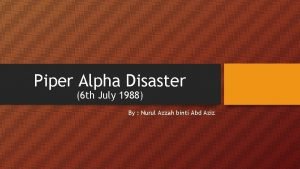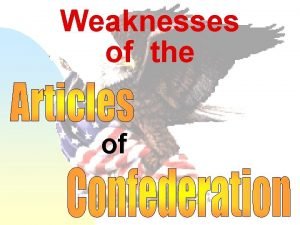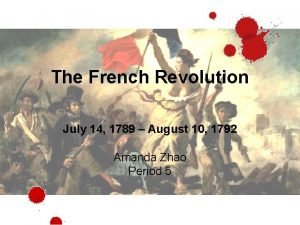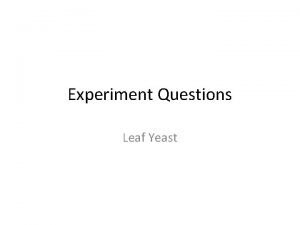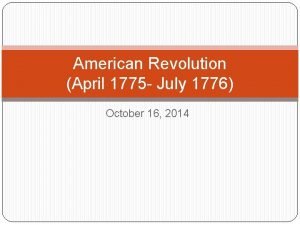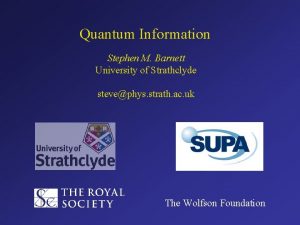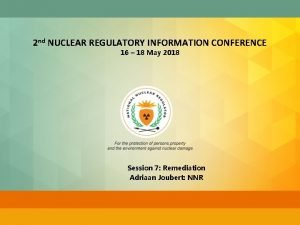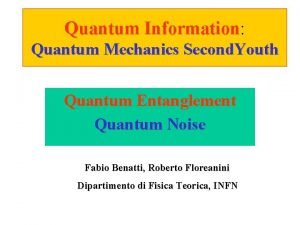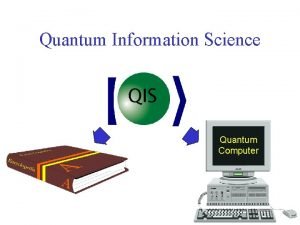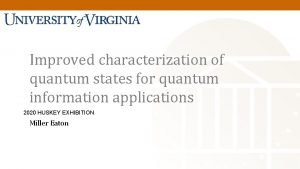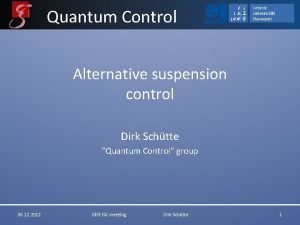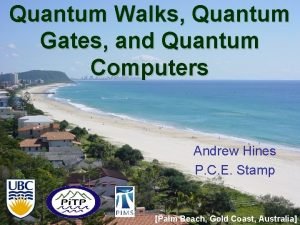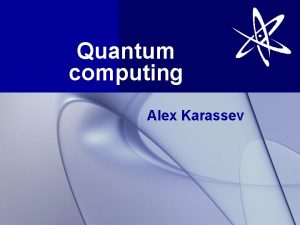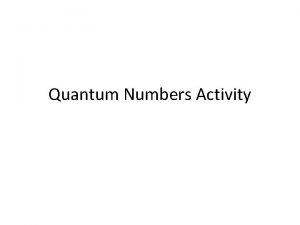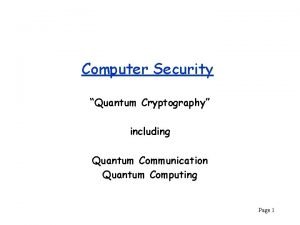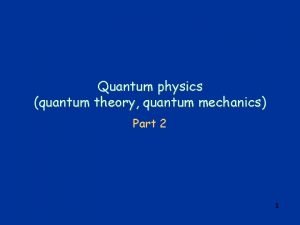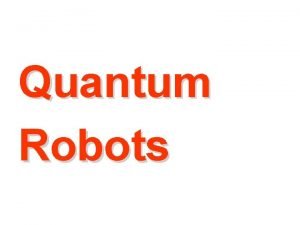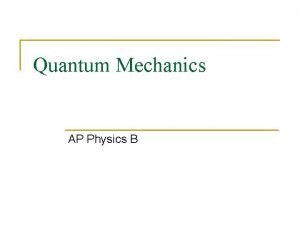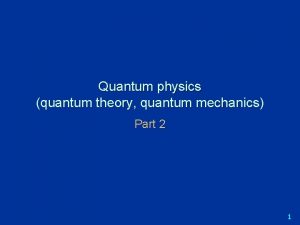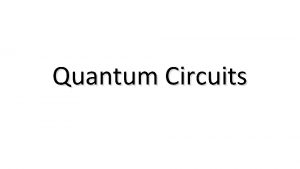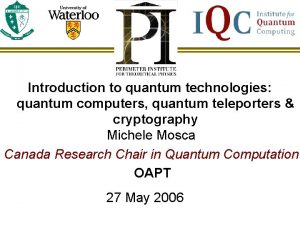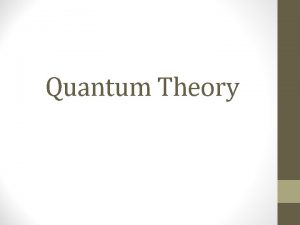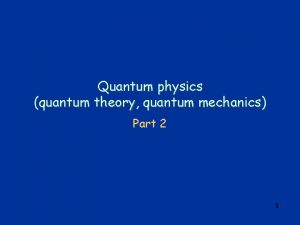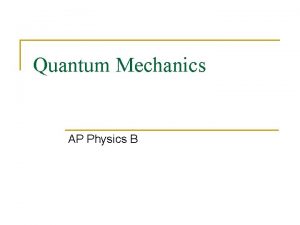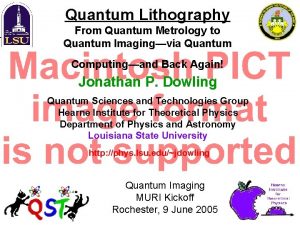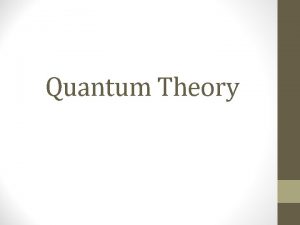Quantum Information and Quantum Control Conference July 19













![Injection from LUMO Ti. O 2 system 9/26/2020 extended in [-101] direction with PBC Injection from LUMO Ti. O 2 system 9/26/2020 extended in [-101] direction with PBC](https://slidetodoc.com/presentation_image/9443d0bafd7917dc73665c6d9e4cdbe4/image-14.jpg)






















- Slides: 36

Quantum Information and Quantum Control Conference July 19 -23, 2004 - University of Toronto, The Fields Institute, Toronto (BA 1170) Creating Molecular Entanglement in Functionalized Semiconductor Nanostructures Sabas Abuabara, Luis G. C. Rego and Victor S. Batista Department of Chemistry, Yale University, New Haven, CT 06520 -8107 Mr. Sabas Abuabara Dr. Luis G. C. Rego* *Current Address: 9/26/2020 Physics Department, Universidade Federal do Parana, CP 19044, Curitiba, PR, Brazil, 81531 -990 1

Photo-Excitation and Relaxation Processes Interfacial electron transfer Add energy diagram here 9/26/2020 Hole relaxation dynamics 2

Aspects of Study Interfacial Electron Transfer Dynamics n Relevant timescales and mechanisms n Total photo-induced current n Dependence of electronic dynamics on the crystal symmetry and dynamics Hole Relaxation Dynamics n Decoherence timescale. n Effect of nuclear dynamics on quantum coherences, coherent-control and entanglement. Luis G. C. Rego and Victor S. Batista, J. Am. Chem. Soc. 125, 7989 (2003); Victor S. Batista and Paul Brumer, Phys. Rev. Lett. 89, 5889 (2003), ibid. 89, 28089 (2003); Samuel Flores and Victor S. Batista, J. Phys. Chem. B, 108, 6745 (2003). 9/26/2020 3

Model System – Unit Cell Ti. O 2 -anatase nanostructure functionalized by an adsorbed catechol molecule 124 atoms: 32 [Ti. O 2] units = 96 catechol [C 6 H 6 -202] unit = 12 16 capping H atoms = 16 9/26/2020 4

Mixed Quantum-Classical Dynamics Propagation Scheme , where and with Short-Time Propagation Scheme 9/26/2020 5

Time-Dependent Molecular Orbitals . . which are obtained by solving the Extended-Huckel generalized eigenvalue equation : . . where H is the Extended Huckel Hamiltonian in the basis of Slater type atomic orbitals (AO’s), including 4 s, 3 p and 3 d AO’s of Ti 4+ ions, 2 s and 2 p AO’s of O 2 ions, 2 s and 2 p AO’s of C atoms and 1 s AO’s of H atoms (i. e. , 596 basis functions per unit cell). S is the overlap matrix in the AO’s basis set. 9/26/2020 6

Time-Dependent Propagation Scheme cont’d For a sufficiently small integration time step t, 9/26/2020 7

Time-Dependent Propagation Scheme cont’d Setting equal to and multiplying by a MO at the iterated time gives the expression when t 9/26/2020 0, 8

Ab Initio DFT-Molecular Dynamics Simulations VASP/VAMP simulation package Hartree and Exchange Correlation Interactions: Perdew-Wang functional Ion-Ion interactions: ultrasoft Vanderbilt pseudopotentials 9/26/2020 9

Model System – Mixed Quantum-Classical Simulations Three unit cells along one planar directions with periodic boundary conditions in the other. Three unit cells [-101] extending the system in [-101] direction System extened in the [010] direction 9/26/2020 [010] 10

Phonon Spectral Density O-H stretch, 3700 cm-1 (H capping atoms) C-C, C=C stretch C-H stretch 1000 cm-1, 1200 cm-1 3100 cm-1 Ti. O 2 normal modes 262 -876 cm-1 9/26/2020 11

Electronic Density of States (1. 2 nm particles) LUMO, LUMO+1 HOMO Valence Band gap =3. 7 e. V Conduction Band ZINDO 1 Band gap =3. 7 e. V Exp. (2. 4 nm) = 3. 4 e. V Exp. (Bulk-anatase) = 3. 2 e. V 9/26/2020 12

Propagation Scheme cont’d Therefore, we can calculate the wavefunction and electronic density for all t>0 and we can also define the survival probability for the electron to be found on the initially populated adsorbate molecule 9/26/2020 13
![Injection from LUMO Ti O 2 system 9262020 extended in 101 direction with PBC Injection from LUMO Ti. O 2 system 9/26/2020 extended in [-101] direction with PBC](https://slidetodoc.com/presentation_image/9443d0bafd7917dc73665c6d9e4cdbe4/image-14.jpg)
Injection from LUMO Ti. O 2 system 9/26/2020 extended in [-101] direction with PBC in [010] direction 14

Injection from LUMO (frozen lattice, 0 K) 9/26/2020 15

LUMO Injection cont’d 9/26/2020 16

PMOL(t) LUMO Injection (frozen lattice) cont’d 9/26/2020 17

Injection from LUMO+1 9/26/2020 18

Injection from LUMO+1 (frozen lattice, 0 K) 9/26/2020 19

PMOL(t) LUMO+1 Injection (frozen lattice) cont’d 9/26/2020 20

LUMO Injection at Finite Temperature (100 K) 0 K PMOL(t) 100 K 0 K 100 K 9/26/2020 21

Hole-Relaxation Dynamics in the Semiconductor Band Gap t=0 ps t=15 ps 9/26/2020 Super-exchange hole transfer 22

Coherent Hole-Tunneling Dynamics 9/26/2020 23

Investigation of Coherent-Control t = 200 fs, w 12 t= k*t 2 -p pulses CB A 1 A 2 … w 12 HOMO superexchange VB Ti. O 2 semiconductor Train 9/26/2020 Adsorbate molecules (A 1, A 2, …) of 2 -p pulses : Agarwal et. al. Phys. Rev. Lett. 86, 4271 (2001)24

Investigation of Coherent-Control cont’d 2 -p pulses (200 fs spacing) 14 ps 60 ps Time, ps 9/26/2020 25

Investigation of Coherent-Control 2 -p pulses (200 fs spacing) 2 ps 9/26/2020 42 ps 26

Reduced Density Matrix: Hole-States Index x indicates a particular initial nuclear configuration 9/26/2020 27

Occupancy Notation Thus these kets describe the state of all three adsorbates -- at once, i. e. , the state of the hole as distributed among all three adsorbates. 9/26/2020 28

Investigation of Entanglement cont’d Example: In the occupancy representation, a state defined by only two nonzero expansion coefficients represents a physical state of maximal entanglement , e. g. , between the center and right adsorbates. 9/26/2020 29

Investigation of Coherences cont’d Compute the subspace density matrix explicitly 9/26/2020 30

Investigation of Coherences cont’d Off-diagonal elements are indicative of decoherence if nuclear motion randomizes the phases, i. e, becomes a random quantity and the average The system will no longer be in a coherent superposition of 9/26/2020 adsorbate states. 31

Investigation of Coherences cont’d Diagonal Elements of the Reduced Density Matrix T=100 K Time, ps 9/26/2020 Off-Diagonal Elements of the Reduced Density Matrix T=100 K Time, ps 32

Investigation of Coherences cont’d Measure of decoherence: 9/26/2020 + + 33

Decoherence Dynamics cont’d 100 fs 9/26/2020 34

Conclusions • We have investigated interfacial electron transfer and hole tunneling relaxation dynamics according to a mixed quantum-classical approach that combines ab-initio DFT molecular dynamics simulations of nuclear motion with coherent quantum dynamics simulations of electronic relaxation. • We have investigated the feasibility of creating entangled hole-states localized deep in the semiconductor band gap. These states are generated by electron-hole pair separation after photo-excitation of molecular surface complexes under cryogenic and vacuum conditions. • We have shown that it should be possible to coherently control superexchange hole-tunneling dynamics under cryogenic and vacuum conditions by simply applying a sequence of ultrashort 2 p-pulses with a frequency that is resonant to an auxiliary transition in the initially populated adsorbate molecule. • We conclude that large scale simulations of quantum dynamics in complex molecular systems can provide valuable insight (into the behavior of the quantum coherences in exisiting materials), which might be essential to bridge the gap between the quantum information and quantum control communities. 9/26/2020 35

Acknowledgments • NSF Nanoscale Exploratory Research (NER) Award ECS#0404191 • NSF Career Award CHE#0345984 • ACS PRF#37789 -G 6 • Research Corporation, Innovation Award • Hellman Family Fellowship • Anderson Fellowship • Yale University, Start-Up Package • NERSC Allocation of Supercomputer Time • Organizing Committee at The Fields Institute, University of Toronto: Paul Brumer, Daniel Lidar, Hoi-Kwong Lo and Aephraim Steinberg. Thank you ! 9/26/2020 36
 Quantum physics vs quantum mechanics
Quantum physics vs quantum mechanics Quantum physics vs mechanics
Quantum physics vs mechanics March april may june
March april may june Missing in venice harris burdick
Missing in venice harris burdick Harris burdick pictures uninvited guest
Harris burdick pictures uninvited guest July 1-4 1863
July 1-4 1863 Tender definition
Tender definition Astronomy picture of the day 11 july 2001
Astronomy picture of the day 11 july 2001 2001 july 15
2001 july 15 2003 july 17
2003 july 17 July 30 2009 nasa
July 30 2009 nasa Sources nso frenchhowell neill mit technology...
Sources nso frenchhowell neill mit technology... What is the significance of july 4 1776 brainpop
What is the significance of july 4 1776 brainpop I am silver and exact i have no preconceptions
I am silver and exact i have no preconceptions Miss cuba receives an invitation
Miss cuba receives an invitation Imagery in poppies in july
Imagery in poppies in july Gdje se rodio nikola tesla
Gdje se rodio nikola tesla Ctdssmap payment schedule july 2021
Ctdssmap payment schedule july 2021 July 1969
July 1969 6th july 1988
6th july 1988 Monday 13th july
Monday 13th july On july 18 2001 a train carrying hazardous chemicals
On july 18 2001 a train carrying hazardous chemicals July 4 sermon
July 4 sermon June too soon july stand by
June too soon july stand by July 2 1937 amelia earhart
July 2 1937 amelia earhart June 22 to july 22
June 22 to july 22 July 12 1776
July 12 1776 Recognizing imagery
Recognizing imagery Super saturday tribal bingo july 4
Super saturday tribal bingo july 4 July 14 1789
July 14 1789 Malaga in july
Malaga in july Leaf yeast
Leaf yeast July 26 1953
July 26 1953 July 16 1776
July 16 1776 Quantum information stephen barnett solutions
Quantum information stephen barnett solutions Regulatory information conference
Regulatory information conference Product control
Product control



















